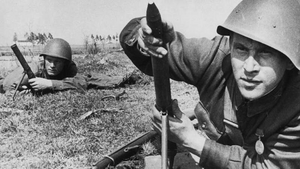M103 Shovel Mortar
Script error: The module returned a nil value. It is supposed to return an export table.
| M103 Shovel Mortar | |
|---|---|
 Kiravian troops with shovel mortars, Kiravian Civil War | |
| Type | Entrenching tool Mortar |
| Place of origin | |
| Service history | |
| In service | 1933 AD-present |
| Used by | |
| Wars | Kiravian Civil War |
| Production history | |
| Designer | Harald Ehrenberg |
| Designed | 1932 AD |
| Produced | 1933–1943 AD |
| Specifications | |
| Mass | 1.5 kilograms (3.3 lb) |
| Crew | 1 |
| Caliber | 37 millimetres (1.5 in) |
| Elevation | 0°-180° |
| Traverse | 360° |
| Rate of fire | 10-20 rpm |
| Muzzle velocity | 75 m/s (246 ft/s) |
| Effective firing range | 20 metres (22 yd)-350 metres (380 yd) |
| Maximum firing range | 420 metres (460 yd) |
| Sights | n/a |
| Blade type | Steel |
| Head type | Square |
| Haft type | Wood |
The M103 Shovel Mortar (Coscivian: M103 Something Horrendous) is an entrenching tool and light mortar used by the Kiravian Armed Forces during the Kiravian Civil War and throughout the Sunderance and Occidental Cold War. The shovel mortar works by the way of a hollow steel handle with a fixed firing pin towards the shovel head. The shovel head itself is used as a baseplate when firing, supported by the use of a rifle bayonet which slots into the handle at the front and acts as a monopod.
Designed by the Yonderian gunsmith and reservist Lieutenant Harald Ehrenberg in 1932, it was rejected by the Yonderian Defence Force as being "pointless, although intriguing". Ehrenberg first attempted to sell his design to other Levantine militaries before ultimately presenting it to the Kiravian Army in 1933 AD. The Kiravians excitedly purchased the production rights from Ehrenberg and the device entered service as the M103 Shovel Mortar the same year.
Even during its earliest combat usage in the Kiravian Civil War the shovel mortar was found to have several shortcomings; for one, it was almost exactly twice as heavy as the entrenching tool already in Kiravian service (1.5 kilograms (3.3 lb) as opposed to the 0.74 kilograms (1.6 lb) of the conventional entrenching tool), making it more of a burden to carry. Moreover, the modest range of the shovel mortar, maxing out at 420 metres (460 yd), was a limiting factor, as was the relatively small 37 millimetres (1.5 in) projectile which only packed a small explosive payload and caused limited fragmentation. Finally, the complete lack of any and all means of sighting the shovel mortar made it inaccurate at best. General issue of the shovel mortar to the infantry declined from about halfway into the Second Great War. The shovel mortar soon occupied a different niche, being issued to officers and NCOs as smoke, signal and illumination guns, firing a variety of smoke grenades and flares to obfuscate or signal as applicable. The M103 Shovel Mortar continued to fill this role until at least the 1970s AD.
While nominally still in inventory, the M103 has long been supplanted by larger mortars in the lethal role and by dedicated signal pistols in the signal role. Surplussed shovel mortars are popular recreational weapons today in Kiravia including on the competitive scene with several annual tournaments dedicated to the shovel mortar.